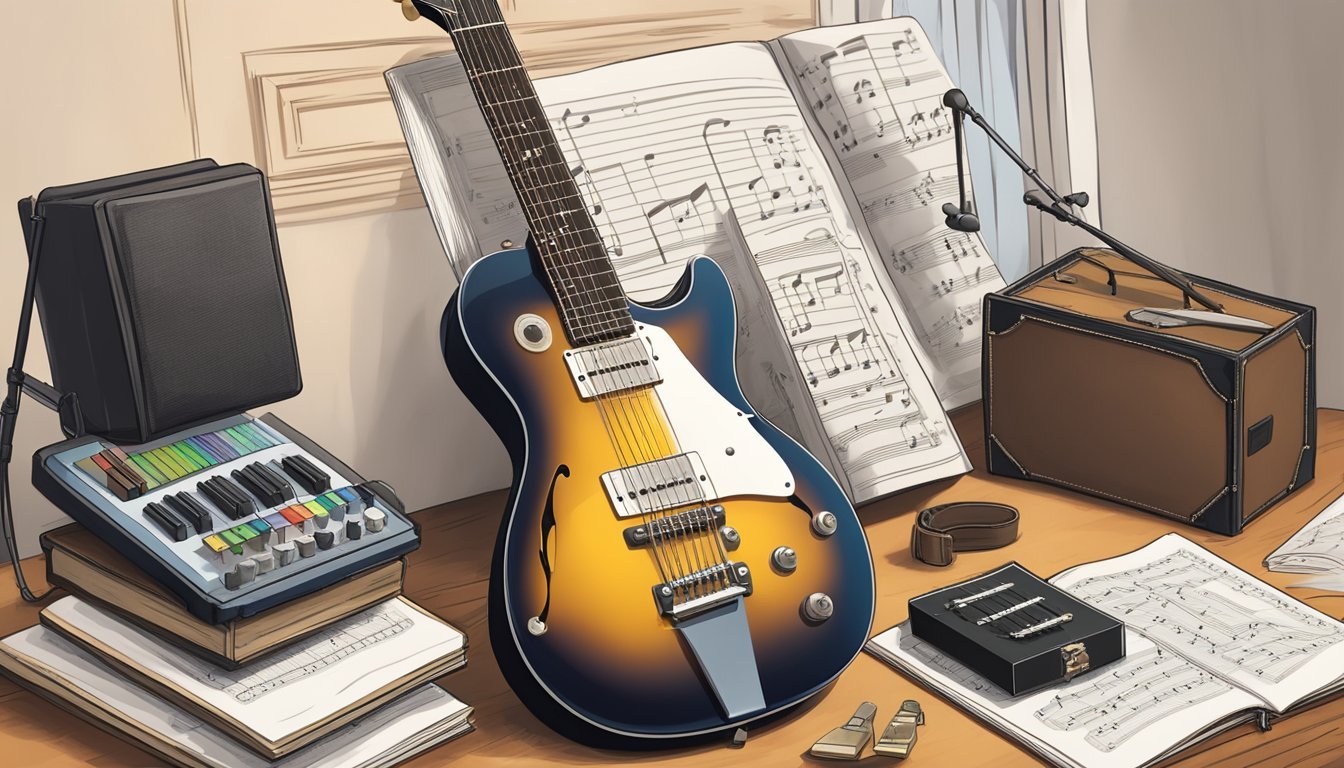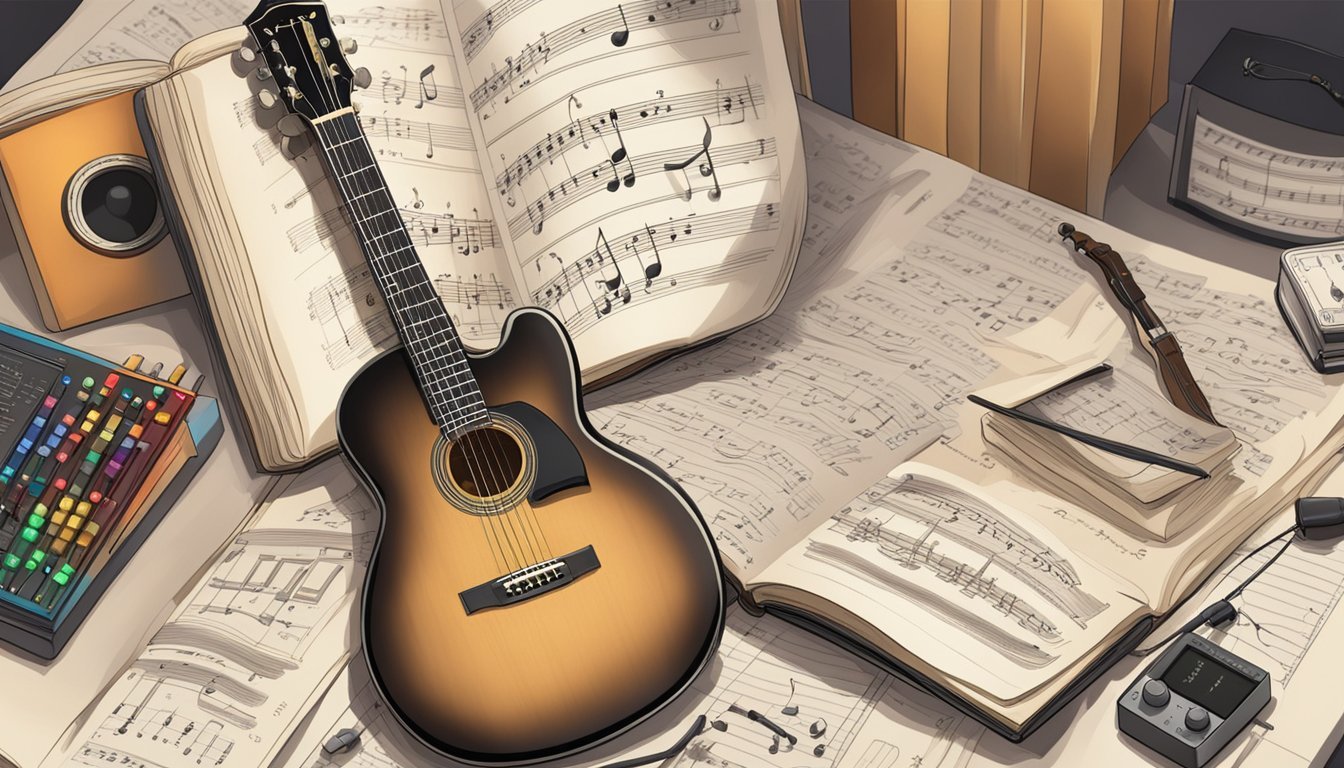Learning to play guitar can be an exciting journey.
You can quickly get started by focusing on a few key skills, like mastering basic chords and learning how to strum.
With regular practice and the right resources, you’ll find yourself playing songs you love in no time.

Whether you’re a complete beginner or someone who has tried before, making progress is all about finding the right methods that work for you.
With the vast number of online tutorials, apps, and communities, you have everything you need to succeed at your fingertips.
Stay patient and enjoy the process; it’s all part of becoming a confident guitarist.
As you keep practicing, remember to mix things up and challenge yourself with new techniques.
Playing your favorite songs will keep the motivation going and make learning feel less like a chore.
There’s a whole world of music waiting for you to explore!
Key Takeaways
- Start with basic chords and strumming techniques.
- Regular practice helps improve your skills over time.
- Playing songs you enjoy keeps the learning process fun.
Getting Started with Guitar Basics
Starting your guitar journey is exciting and can be simple.
You’ll want to choose the right guitar, understand its parts, and learn how to tune it properly.
This foundation will set you up for success as you dive into playing.
Choosing Your First Guitar
When picking your first guitar, consider whether you want an acoustic or electric model. Acoustic guitars are great for beginners because they are easier to play and don’t need any extra equipment. Electric guitars can be fun, but you’ll need an amplifier and other gear.
Think about the guitar brands known for quality, like Yamaha, Fender, or Gibson.
Look for a guitar with a good neck and smooth frets.
Try out different guitars and see what feels comfortable in your hands.
If possible, bring a friend or teacher for guidance.
Don’t forget to consider your budget—there are good options at all price levels.
Learning the Parts of the Guitar
Knowing the parts of the guitar will help you get familiar with your instrument.
Here are the main parts:
- Headstock: This is where the tuning pegs are located.
- Nut: The piece at the end of the fretboard that helps guide the strings.
- Fretboard: This is where you press down on the strings to create notes.
- Frets: These are metal bars on the fretboard that help you find the correct pitches.
- Body: The large part of the guitar that affects sound.
- Bridge: Holds the strings in place and transfers vibrations to the body.
Getting to know these components helps you understand how to play more effectively.
Understanding Guitar Tuning
Tuning your guitar is key to making it sound right.
Most guitars use standard tuning, which means the strings are tuned to E, A, D, G, B, and E from thickest to thinnest.
Using a guitar tuner can make this process much easier.
To tune, play each open string and adjust the tuning pegs until they match the tuner’s notes.
Always check tuning before you start playing.
Keeping your guitar in tune will help you develop your ear for music and ensure that everything sounds great together.
Regular tuning is just part of the practice!
Mastering Fundamental Guitar Skills
To become a good guitarist, start with the basics.
You need to feel comfortable with your instrument and learn some essential skills.
This will set the stage for playing songs and enjoying music.
Getting Comfortable with Holding the Guitar
First, you want to find a good way to hold your guitar.
If you’re playing sitting down, rest it on your right leg (for right-handed players) and keep the neck at a slight angle.
A good guitar strap can help if you prefer to stand.
Make sure you can reach the frets easily.
Practice holding the guitar while keeping your back straight.
This helps you play longer without getting tired.
Relax your shoulders and don’t grip the neck too tightly.
Your fingers should hover lightly over the strings, ready to play.
Your First Chords and Strumming Patterns
Start with some simple chords like E minor and G major.
These basic guitar chords are the building blocks for many songs.
Check out chord charts to see where to place your fingers.
Once you can play the chords, try some basic strumming patterns.
A simple down-up strum can make your chords sound great.
You can mix in power chords later to add depth to your sound.
Remember, practice is key! Play along with your favorite songs to get the hang of it.
Developing Finger Independence and Strength
Finger independence is important for playing chords smoothly.
Start with finger exercises to build strength and dexterity.
Try placing one finger on each fret, moving from the first to the fourth fret.
You can also practice switching between chords without looking at your hands.
This will improve your coordination.
Use a metronome to keep a steady pace.
As you build your skills, you’ll find it easier to strum chords and play your first song with confidence.
Progressing with Advanced Techniques

As you advance in your guitar playing, it’s important to dive into new skills that will enrich your musical journey.
This includes learning how to read guitar tabs and chord charts while also exploring various musical genres.
Reading Guitar Tabs and Chord Charts
Learning to read guitar tabs and chord charts is essential for expanding your skills.
Tabs give you a visual representation of where to place your fingers on the fretboard.
Each line represents a string, and the numbers show which fret to play.
Chord charts help you understand finger placement for chords.
They show the entire chord in one glance.
This makes it easier to learn new songs quickly.
Make it a habit to practice with tabs from your favorite songs.
This will improve both your rhythm and your ability to pick single notes smoothly.
Plus, playing along will make practice more fun!
Exploring Different Musical Genres
Exploring different musical genres can greatly enhance your guitar skills.
Each style, like rock or blues, has unique techniques.
For instance, rock often features catchy riffs and power chords.
Learning these can improve your abilities and keep things interesting.
Blues focuses heavily on bending notes and using specific scales.
This style can help you develop a deeper feel for the music.
Try playing along with tracks from various genres.
This way, you’ll understand the nuances of each style.
Plus, adapting to different rhythms and techniques can make you a more versatile guitarist.
Practicing and Playing Your Favorite Songs
Practicing your favorite songs makes learning the guitar fun and motivating.
By breaking down songs into manageable parts and creating the right environment, you can boost your skills while enjoying the music you love.
Learning Songs Through Video Lessons
Using video lessons is an effective way to learn new songs.
Websites like Guitar Tricks offer a variety of step-by-step lessons tailored for different skill levels.
You can search for your favorite songs and follow along with visual instructions.
This method allows you to learn at your own pace and revisit tricky sections as needed.
Start by choosing a song that excites you.
Then, watch how the instructor plays each chord and riff.
Don’t hesitate to pause the video and practice until you feel comfortable.
Remember, repetition is key.
As you improve, consider challenging yourself with more complex songs!
Creating a Learning Environment
Setting up a good learning environment is crucial.
Make sure your practice space is comfortable and free from distractions.
Find a quiet spot where you can focus.
Having your guitar and any necessary equipment close by will help.
Consider keeping a notebook to jot down progress or notes about your practice sessions.
You might also want to play along with backing tracks or your favorite songs.
This will keep you engaged and make your practice sessions more enjoyable.
Create a schedule that fits your routine and stick to it.
Consistency will help you see your guitar skills grow!
Frequently Asked Questions
Learning guitar can bring up a lot of questions.
Here are some answers to help you get started on your guitar journey.
Whether you’re wondering about basic chords, strumming patterns, or how to build finger strength, getting the right guidance is essential.
If you’re specifically looking for tips on how to play Lover on guitar, start by practicing the chord progression and working on smooth transitions.
With patience and consistent practice, you’ll be playing your favorite songs in no time!
What are some effective methods for beginners to learn guitar?
Beginner methods often include taking lessons, using online tutorials, or practicing with apps.
You might also want to learn songs you love, as this keeps things fun and interesting.
Can I teach myself guitar, and if so, what resources are available?
Absolutely, you can teach yourself guitar! There are tons of resources, like free online videos, apps, and websites that offer structured lessons.
Look for beginner courses that focus on chords and strumming patterns.
What are the best ways for adults to start learning guitar?
As an adult, you might find it helpful to set specific goals.
Start with simple songs and practice consistently.
Online courses can be very effective for catered learning at your own pace.
Are there any tricks or techniques to make learning guitar easier?
Using a metronome can help you develop rhythm, while learning in small chunks keeps it manageable.
Also, consider breaking down songs into sections and practicing slowly.
How long does it typically take to learn the basics of guitar?
The time it takes varies, but many people can learn the basics in a few months with regular practice.
Aim for about 20-30 minutes of practice a day for steady progress.
What are some reliable sources to learn guitar chords for free?
You can find free chord charts on various websites and apps.
For example, websites like Hello Music Theory have great resources.
Also, YouTube channels that focus on beginner lessons are a good option.

